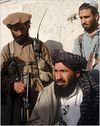Tensions within the Taliban ranks in South Waziristan have risen for the second time in a year. The powerful Taliban commanders Baitullah Mehsud and Mullah Nazir are close to clashing after two of Nazir’s offices were attacked. Nazir is blaming Baitullah’s forces for the attacks, which claimed the lives of nine of Nazir’s tribesmen.
The conflict began on Jan. 6, when the office of Mullah Nazir in Wana was attacked, Dawn reported. Three of Nazir’s associates were killed and four wounded. The second attack occurred against the office of Haji Khanan, a close ally of Nazir’s based out of Shakai. Six were killed and five were wounded.
Nazir immediately placed the blame on Baitullah Mehsud’s forces. “We suspect Baitullah and his Uzbek supporters for this gruesome attack which left nine Mujahideen dead,” said Lala Wazir, a tribesman of Nazir. Nazir, an influential leader of the Ahmadzai Wazir tribe and a powerful Taliban commander in South Waziristan, has ordered the members of the Mehsud Wazir tribe to leave the Wana area “otherwise they will be responsible for consequences,” said Lala.
This is the second clash between Nazir’s Taliban and rival elements in South Waziristan. During the spring of 2007, Nazir’s Taliban fighters battled with rival Taliban forces that backed the Najimuddin al Uzbeki’s contingent of Uzbek fighters of the Islamic Jihad Group. Both Nazir and his ally Haji Khanan are opposed to the presence of Uzbeks, Chechens, and others who settled in the region after the US invasion of Afghanistan in 2001.
Nazir began battling the Uzbek contingent after he accused them of assassinating Arab al Qaeda operatives Saiful Asad and Sheikh Asadullah, a Saudi. Asadullah was one of Nazir’s lieutenants and served as al Qaeda’s financiers in the region. Asadullah replaced Ahmad Saeed Abdur Rehman Khadr al Kanadi, an al Qaeda operative who was killed in 2004. Kanadi was “designated by the United Nations as a high-ranking al Qaeda member.”
The Pakistani government was quick to claim Nazir was a “pro-government” tribesman, and provided military support against the Uzbek contingents. The Pakistani military inflated the number of Uzbek deaths in an attempt to demonstrate the South Waziristan peace agreement was working.
But Nazir is anything but pro-government. He openly supports al Qaeda and its leadership, and last year he admitted he would provide shelter to senior al Qaeda leaders. “How can I say no to any request from Osama bin Laden or (Taliban leader) Mullah Omar under tribal traditions, if they approach me to get shelter?” Nazir said. He also openly supports the continuation of the jihad in Afghanistan and vowed to provide fighters to support the Taliban across the border. The Taliban and al Qaeda operate at least 29 training camps in North and South Waziristan.
The April 2007 fighting between Nazir’s forces and the Uzbeks was resolved after senior Taliban leaders in Afghanistan and Pakistan intervened. Baitullah and Sirajuddin Haqqani were called in to broker the ceasefire. Baitullah was appointed the leader of the newly created Movement of the Taliban in Pakistan, an umbrella group organizing the Taliban throughout the tribal agencies and the Northwest Frontier Province in mid-December 2007.
See The Fall of Waziristan: An Online History, The Pakistani Taliban Org Chart, The Taliban’s internecine war in Waziristan, and Spinning the Fighting in South Waziristan for more information on Mullah Nazir and the fighting in South Waziristan in 2007.










3 Comments
The Thunder Run has linked to this post in the – Web Reconnaissance for 01/09/2008 A short recon of what’s out there that might draw your attention, updated throughout the day…so check back often.
Once again the annual feud with the Uzbeks. Wasn’t this where things started out last spring? To quote Yogi Berra “This is like Deja vu all over again.”
What a difference a few days make.
No, I do not mean the McCain defeat of Obama in new Hampshire chronicled by Sean or even my Victor Davis Hanson comment on same:
Here is Professor Hanson on the apparent winners, McCain and Hillary – http://victorhanson.com/articles/hanson010808.html…